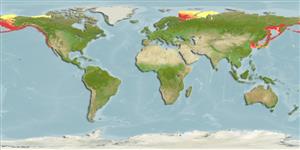Classification / Names
Common names from other countries
Main reference
Size / Weight / Age
Max length : 46.0 cm TL male/unsexed; (Ref. 27436); common length : 25.0 cm SL male/unsexed; (Ref. 188); max. reported age: 19 years (Ref. 27547)
Length at first maturity
Lm 21.4 range ? - ? cm
Environment
Marine; freshwater; brackish; pelagic-neritic; non-migratory; depth range 0 - 475 m (Ref. 58426)
Climate / Range
Temperate, preferred 4°C (Ref. 107945); 77°N - 33°N, 34°E - 119°W (Ref. 54336)
Distribution
Arctic: White Sea eastward to Ob inlet. Western Pacific: Anadyr Bay, eastern coasts of Kamchatka, possibly the Aleutian Islands southward to Japan and west coast of Korea. Eastern Pacific: Kent Peninsula at 107°W and Beaufort Sea southward to northern Baja California, Mexico.
Countries | FAO areas | Ecosystems | Occurrences | Introductions
Short description
Dorsal
spines
(total): 0;
Dorsal
soft rays
(total): 13-21;
Anal
spines: 0;
Anal
soft rays: 12 - 23;
Vertebrae: 46 - 58. Without prominent keel; no median notch in upper jaw. Gill cover without radiating bony striae. No distinctive dark spots on body or fins. Overlaps C. harengus in White Sea, but distinguished by fewer vertebrae (usually 52 to 55; cf. usually 55 to 57) and fewer post-pelvic scutes (10 to 14; cf. 12 to 16). Dark blue to olivaceous above, shading to silver below (Ref. 27547). Precaudal vertebrae: 29-31-32; caudal vertebrae: 19-22-22 (Ref. 265).
IUCN Red List Status (Ref. 115185)
Threat to humans
Harmless
Human uses
Fisheries: highly commercial; gamefish: yes; bait: usually
Tools
Special reports
Download XML
Internet sources
Estimates of some properties based on models
Phylogenetic diversity index
PD50 = 0.6250 many relatives (e.g. carps) 0.5 - 2.0 few relatives (e.g. lungfishes)
Trophic Level
3.2 ±0.2 se; Based on diet studies.
Resilience
Medium, minimum population doubling time 1.4 - 4.4 years (Musick et al. 2000 (Ref. 36717))
Vulnerability
Low to moderate vulnerability (28 of 100)
Price category
